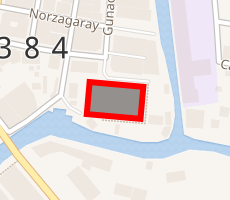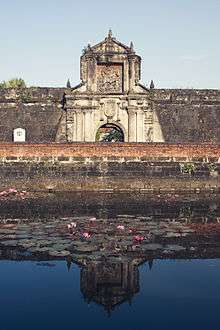Masjid Al-Dahab
Masjid Al-Dahab (or The Golden Mosque; Filipino: Gintong Masjid) is situated in the predominantly Muslim section of the Quiapo district in Manila, Philippines, and is considered the largest mosque in Metro Manila.
| Masjid Al-Dahab Gintong Masjid | |
|---|---|

| |
| Religion | |
| Affiliation | Islam |
| Location | |
| Location | Manila, Philippines |
| Geographic coordinates | 14°35′44.5″N 120°59′6.5″E |
| Architecture | |
| Type | Mosque |
| Completed | 1976 |
| Specifications | |
| Capacity | 22000 |
| Dome(s) | 1 |
| Minaret(s) | 1 |
The Golden Mosque acquired its name for its gold-painted dome as well as for its location in Globo de Oro Street. Under the supervision of former Philippine First Lady Imelda Marcos, construction began on August 4, 1976 for the visit of Libya's President Muammar al-Gaddafi, although his visit was cancelled. It now serves many in Manila's Muslim community, and is especially full during Jumuah prayers on a Friday. The mosque can accommodate up to 22,000 worshippers. [1]
The mosque incorporates a mixture of foreign and local influences. Its dome and erstwhile minaret are patterned after Middle Eastern structures whereas its geometric designs borrow much from the colors and variations of ethnic Maranao, Maguindanao, and Tausug art. The curved lines are based on the serpent motifs in Maranao art.[1] The mosque used to exhibit stained glass panels by artist Antonio Dumlao. [2]. The glass panels are now at the Far Eastern University.
According to the mosque administrators, the minaret was torn down due to problems in structural integrity at the time of former Mayor Lito Atienza. There are already plans to rebuild the minaret as donations from all over the world are pouring in to reach the target of 12 million Philippine Pesos. The measurement of its dome is 12 meters in diameter and 10 meters in height
Transportation
The mosque is accessible within walking distance south east of Carriedo LRT Station of Manila LRT.
References
- Angeles, Vivienne (2009). "Constructing Identity: Visual Expressions of Islam in the Predominantly Catholic Philippines". Identity in Crossroad Civilisations: Ethnicity, Nationalism and Globalism in Asia. Amsterdam University Press: 195–218.
- Rodell, Paul (2002). "Culture and Customs of the Philippines". Greenwood Publishing Group. Cite journal requires
|journal=(help)
External links
- „Golden Mosque“, Globo de Oro str., Quiapo, Manila. Pinoy Travel Blog, 2006.
- Vistapinas: Golden Mosque

